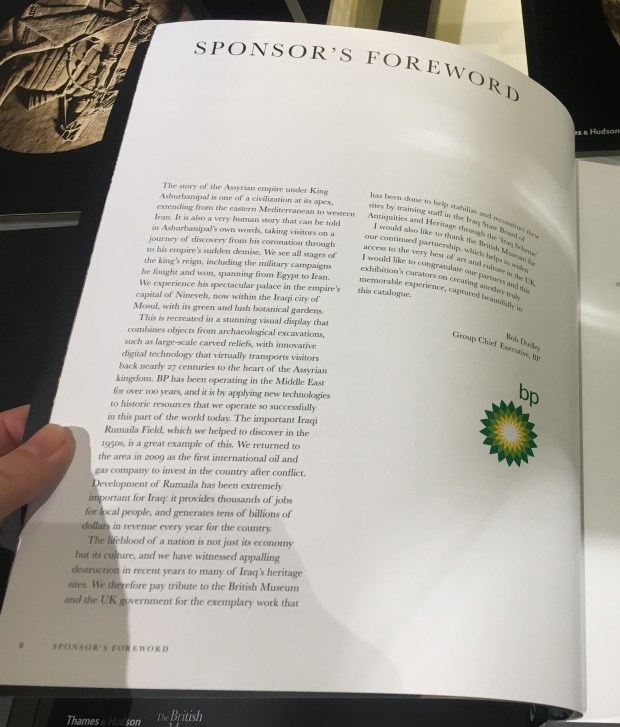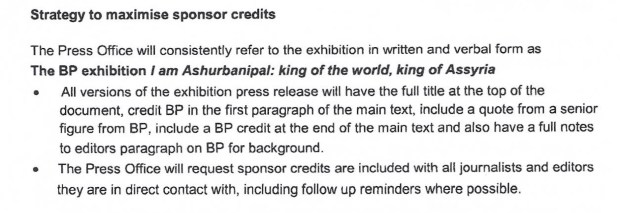Last Saturday, the British Museum encountered what was perhaps the biggest protest in its 260-year history. The activist theatre group BP or not BP? – accompanied by Iraqi activists and over 300 supporters – creatively took over the museum’s Great Court in opposition to BP sponsorship of the museum’s exhibition, I am Ashurbanipal: King of Assyria, King of the World. This Sunday, it will close its doors to the public. But over the course of its 4-month run, this high-profile exhibition featuring artefacts from what is now modern-day Iraq has given BP a valuable opportunity to put a positive spin on its business in the country.
Prior to the invasion of Iraq in 2003, the oil giant lobbied and met with UK government officials multiple times in a bid to make sure its business interests would be catered for, telling them it was ‘desperate’ to get into Iraq and anxious that political deals should not ‘deny it the opportunity’. Now, some 15 years later, BP is the operator of the super-giant Rumaila oil field in the south of Iraq and is developing the Kirkuk oil field in the north. The oil company’s proactive efforts to profit from the 2003 invasion clearly paid off.
‘The liaison with BP has been difficult this week as they are of the opinion that [the logistics sponsor’s] crediting is too prominent. This has led to some very difficult conversations.’
– British Museum staff member
Now, following Freedom of Information requests, we have acquired new emails and meeting notes – which we are making public today – from both the Foreign & Commonwealth Office (FCO) and the British Museum which shed light on their relationships with BP, both around its operations in Iraq and the Ashurbanipal exhibition. Crucially, they reveal that at the British Museum, BP’s eagerness to boost its brand may be starting to take its toll.
Full FOI materials are available at the end of this post.
BP and the UK Government: a legacy of lobbying
In 2011 in his book ‘Fuel on the Fire’, oil industry researcher Greg Muttitt revealed a whole cache of meeting notes between BP and the UK government from 2002-3 ahead of the invasion of Iraq. One meeting in particular stands out, where a home office official summarised that:
‘Iraq is the big oil prospect. BP are desperate to get in there and anxious that political deals should not deny them the opportunity…’
Details of the meetings were gained through Muttitt’s persistence, with the FCO and BP initially denying notes existed or that the meetings took place. So when we made a Freedom of Information request to the Foreign & Commonwealth Office (FCO) for details of its meetings with BP last year, their patchy response was perhaps unsurprising. For some meetings, such as one on the 26th March at the British Embassy in Baghdad, there is once again a worrying lack of transparency. The FCO openly admits there was, ‘No record or agenda’ and ‘No emails’ associated with that meeting. In other parts of their response, key details have been redacted in order to protect BP’s ‘commercial interests’.
BP’s glowing review from the British Ambassador
Last year, on 9th April 2018, the British Ambassador in Iraq visited BP’s Operations Base at the Rumaila oil field as part of a wider visit to the region. Revealingly, an email to the Ambassador the day before the trip informed him that:

After his visit, the British Ambassador takes to Twitter to lavish praise on BP.
Following the trip, a summary was sent to the Ambassador but here, disclosed to us with multiple redactions. It recorded the following:

But we know that this glowing summary of BP’s activity in the region is at odds with the reality on the ground. Just months after the Ambassador’s visit to BP’s operations, tens of thousands in the region protested against the mass unemployment that still existed on the doorstep of Iraq’s lucrative oil reserves, as well as against corruption and political nepotism. The protests were also a response to collapsing infrastructure which has led to power cuts, water shortages, a lack of basic healthcare and undrinkable water. Some even made their protests at the actual gates of BP and other foreign oil companies.
Ali, who was involved in the mass protests in 2018, said:
‘In Basra you see the wealth pouring out of the community every day – from oilfields over there, less than a kilometre from where we are sitting – and then you see the poverty and lack of employment in the villages, while companies import thousands of foreign workers’
And Iraqi economist Kamil Mahdi, has also noted that:
‘Extreme health and energy-poverty conditions have worsened as the activities of BP and other companies have expanded and as oil production and exports increased. It is not good enough for these companies to claim they are not directly responsible for the outcome.’
Further to these personal accounts, a government official in Basra said in 2015 that the province records 50 new cancer cases each month due to the polluted air that is associated with oil extraction. And in 2018, Basra Province’s Health and Environment Committee revealed that four new cancer cases are registered every day as a result of air pollution.
But if you were to visit the Ashurbanipal exhibition at the British Museum, view the introduction display board or read the ‘Sponsor’s Foreword’ to the exhibition book, you would only hear about BP’s ‘sustainable social investment programme’ which is supposedly ‘focused on improving health, access to potable water, community infrastructure and vocational training’.

Photo courtesy of BP or not BP?
Is my BP logo big enough?
Of course, it’s no secret that BP uses its partnership with the British Museum to boost its business interests and clean up its brand – BP’s Vice President Peter Mather admitted as much in an interview with the Times in 2016:
‘When there is an option, naturally we are going to try to match a particular exhibition with somewhere we have an interest.’
And when it came to this latest so-called ‘BP exhibition’ at the British Museum, the oil company’s motivations were as cynical as ever. A member of British Museum staff, speaking anonymously in 2016, described how BP’s behaviour as a sponsor was ‘extremely demanding’ and ‘bullying’. Now, emails disclosed to us following an FOI request suggests little has changed. Ahead of the exhibition, the relationship strained as the limelight-stealing BP felt recognition of its fellow sponsor – IAG Cargo – was too big:
![]()
Emails suggest that staff at the museum went to some lengths to demonstrate to BP the consistency in its crediting:

A subsequent email by the Senior Marketing Manager at the museum also confirms that BP will get ‘title crediting’ on the museum’s postal frank.
![]()
Again, it appears that BP’s recognition is an ongoing priority and here, may have even come above the perhaps more essential information of when the exhibition would take place. It is these tangible, measurable aspects of the sponsorship deal that are of interest to BP as opposed to any desire to sustain the cultural sector.
While recognition of a sponsor is not unusual in itself, pages from the museum’s marketing strategy for the exhibition are revealing. One page outlines the ‘strategy to maximise sponsor credits’ including ‘follow-up calls’ to journalists who fail to include mention of BP.

And just a few pages later, a table demonstrates the significant extent of the brand exposure BP gets from the sponsorship deal, identifying just some of the many instances where the company’s logo will appear.

Click here to view the full list of sponsor credits.
Boosting BP’s brand at the exhibition launch
While BP staff have always had a presence at the launch of sponsored exhibitions, it is normally its Head of Arts & Culture Des Violaris who attends alongside Peter Mather. However, it is telling that for the launch of the Ashurbanipal exhibition, they were accompanied by Michael Denison, BP’s Group Political Advisor as well as other BP guests.

Denison’s presence perhaps signals that BP views its sponsorship of the Ashurbanipal exhibition as being of particular strategic value. Also, his presence demonstrates that the British Museum is fully aware of how BP uses its sponsorship deal strategically to build its cultural and political influence and ultimately, further the extraction of fossil fuels.

It was Peter Mather though who was invited to speak at the press launch although an early draft of his remarks raised eyebrows at the British Museum. It seemed BP had failed to grasp the content of the exhibition it was sponsoring, with staff at the museum commenting that:

And:

The reference to permafrost suggests that BP had lazily copied and pasted remarks from the launch of the previous BP-sponsored exhibition, which included artefacts from Siberia that had been preserved in permafrost. So while BP is eager to highlight in the exhibition press release that it ‘has a history in Iraq, stretching back to the 1920s’, it seems the company’s engagement with Iraq’s culture – unlike its oil – is much more superficial.

And as with previous exhibition launches, the museum came prepared with pre-drafted answers for any probing questions on its BP partnership, such as:
‘What is the museum’s response to increasing activism by groups like Art Not Oil?’
And:
‘BP funding only accounts for 1% of the museum’s income – so why do you need it?’
Click here to view the full list of prepared questions and answers on BP sponsorship.
But despite this preparation, the museum appears to have still been uneasy. In a shift in protocol – and marked in bold – the museum made a change to the usual format for such launch events:

Of course, the museum might well have had other motives for the change but shifting away from an open Q&A, where all journalists could potentially report on any uncomfortable questions that are raised, does suggest a shift away from transparency and towards a situation where it can more carefully control the message.
These new emails and other documents only offer us a snapshot of BP’s engagement with the FCO and the British Museum – but what they reveal is not insignificant. BP’s role in the 2003 invasion of Iraq and its impacts in the country today have been well-documented yet the British Museum unquestioningly provides the company with an opportunity to project an image of itself as ethical and socially responsible. And similarly, the FCO readily invites, accepts and tweets out BP’s spin on its business in Iraq.
For the museum to have known that BP was involving its ‘Group Political Advisor’ in the exhibition press launch – while it cut out the open Q&A and pre-scripted answers to defend BP’s reputation – is particularly concerning though. Once again, the British Museum has shown that it is fully aware of its sponsor’s cynical motivations and is doing more than just turning a blind eye. But with difficult internal conversations emerging over just the size of BP’s logo – and with hundreds protesting in the museum at the weekend – this sponsorship deal seems to be on increasingly shaky ground.
You can view the full Freedom of Information disclosures here:
Foreign & Commonwealth Office
Digest of meetings and emails, January-August 2018
British Museum
Notes or internal briefings in relation to the launch of Ashurbanipal exhibition
Copies of any marketing plans/related correspondence for the Ashurbanipal exhibition

One thought on “How the British Museum and Foreign Office boost BP’s spin on Iraq”
Comments are closed.